Rob’s Recipe of the Week: Huauzontle fritters
This week we’re getting an unusual vegetable, Huauzontle. After a fair bit of digging it seems it’s impossible to talk about Huauzontle without mentioning the dish “Tortas de Huauzontle”, which are small battered and deep fried fritters of Huauzontle and cheese, so that has to be my recipe for this week. If this doesn’t take your fancy though it seems the best alternative is to treat it like broccoli, maybe by sauteing with onion/garlic/cumin/vinegar.
Tortas de Huauzontle
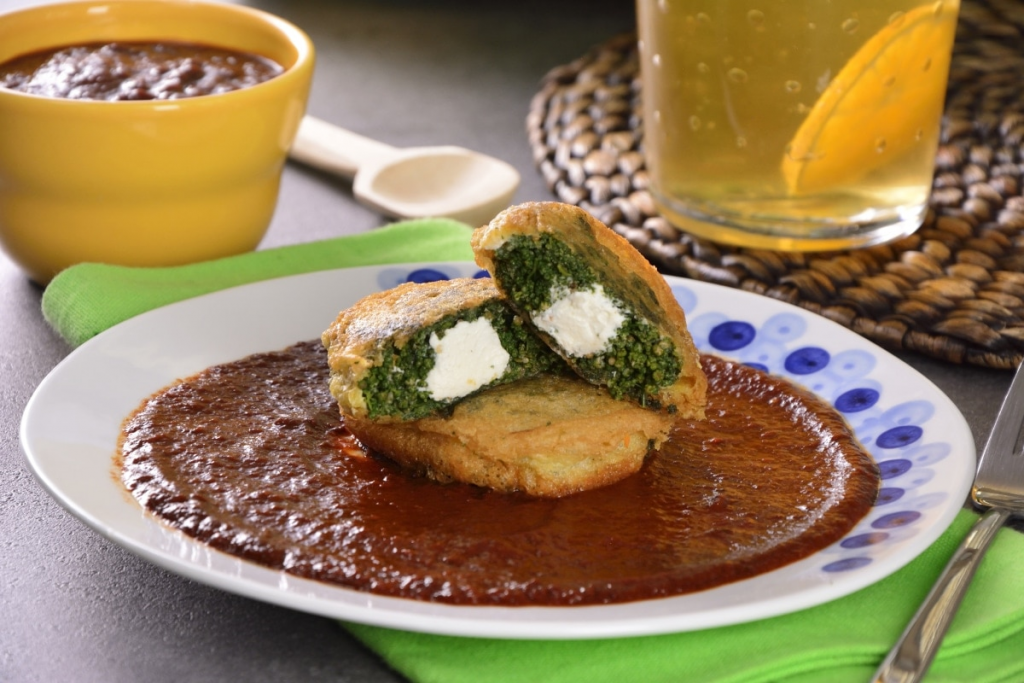
Ingredients (will need scaling according to your share):
Tortas:
1 1/2 liters Water
1 teaspoon salt
4 cups huauzontle, clean, without branches
190 grams cream cheese (or alternative)
1/2 cups flour
4 egg whites (For batter. For vegan alternative try a gram flour batter)
4 egg yolks
enough oil, to fry
Sauce:
3 pasilla chili peppers (deveined and soaked – try canalside dried chilis but beware they’re much hotter)
2 tomatoes
1/4 onions
2 cloves garlic
1/2 cups Water
2 tablespoons oil
salt
Method:
Cook huauzontles in salted water for 5-10 minutes (cook time varies wildly from recipe to recipe, cook for longer if you’re only shallow frying I think)
Place the huauzontles in a bowl of water with ice.
Remove the huauzontles and dry on a tea towel to remove moisture.
Strip everything from the bitter stalk and discard this.
Form a burger like patty in your hands by squeezing the huauzontle around a chunk of cream cheese, flouring the outside.
In a blender beat the egg whites with a pinch of salt, until peaks form
Add the yolks and beat for 1 minute more to integrate.
Dip the huauzontle pancakes in the batter.
Heat the oil over medium heat and fry 2 minutes on each side. (Make the sauce first)
For the sauce, blend the chilies, tomato, onion, garlic and water for 3 minutes.
Heat the oil over medium heat, pour the sauce, season with salt and let it cook for 15 minutes.
Serve the huauzontle pancakes bathed in pasilla sauce.
Recipe adapted from:
https://us.kiwilimon.com/recipe/main-dishes/huauzontle-pancakes-with-sauce-from-chile-pasilla
https://www.atastefortravel.ca/3408-huauzontle-puerto-escondido-mexico/#wprm-recipe-container-12833
Rebecca’s Recipe of the Week: Lebanese Tabouli
When I was growing up, tabouli formed part of my father’s very limited cooking repertoire, alongside steak tartare and chicken marsala. The recipe he used called it ‘non-lettuce salad’, and that’s a good description of this blend of parsley, mint, tomatoes, cucumbers and a little bulgar wheat. I dedicate this recipe to him!
The secret to this tabouli is the Lebanese 7-spice blend. For an absolute feast, serve it with Lebanese 7-spice chicken. It’s pretty good on its own, too.
Lebanese Tabouli
Serves 4
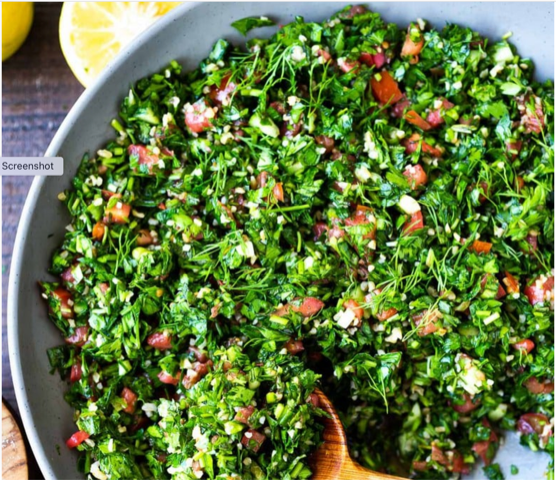
Ingredients
7 Spice Blend Ingredients
1 teaspoon ground coriander
1 teaspoon cumin
1 teaspoon cinnamon
1 teaspoon ground allspice
1/2 teaspoon grated nutmeg
1/2 teaspoon ground cloves
1/2 teaspoon ground cardamom
Tabouli ingredients
250ml dry medium grain bulgar wheat
4 spring onions
1 large bunch flat-leaf parsley
1 cup mint leaves
1 small bunch dill
3 medium tomatoes
1 cucumber
1 tablespoon lemon zest
70ml lemon juice, or to taste
125ml cup olive oil
1 teaspoon salt
1 teaspoon 7-Spice mix
Preparation
First prepare the 7-spice blend. This will make more than you need for the tabouli, but that shouldn’t be a problem since it’s so delicious. You can add it to lots of other things, including this splendid Lebanese 7-spice chicken. To make the blend combine all the ingredients together. If you want really to go to town with it, you can roast whole coriander and cumin seeds and then grind them, before combining with the other ingredients. This gives an added warm depth to the spice blend.
To make the salad, first prepare the bulgar wheat. Put it in a small bowl and pour 250ml boiling water over it. Cover with a plate, and set aside for at least 30 minutes while you prepare the rest of the salad. This allows the grains to soften.
Slice the spring onion and place in a large serving bowl.
Chop the parsley as fine as you can. It’s ok to include the thinner stems. Add to the bowl. Chop the mint and dill and add them as well.
Dice the tomatoes and cucumbers into small cubes and add them to the bowl, along with all their juices.
Add the lemon zest, lemon juice, olive oil, salt and 1 teaspoon of the 7-spice mix. Give it all a good stir.
By now 30 minutes have probably passed, so the bulgar wheat should be al dente. Once it is, add it to the salad as well and mix again.
If you have time, let the salad sit for a few hours to allow the flavours to meld. The parsley will soften and the bulgar will soak up the flavourful juices. It will in any event be very good the next day if there is any left over.
Before serving, give a stir and taste for salt, lemon and 7-spice. Adjust to your liking. Slyvie Fountaine, whose recipe this is, says ‘You want just the faintest whiff of the spices, like a whisper’.
Recipe adapted from Sylvia Fountaine, ‘Feasting at Home’. https://www.feastingathome.com/lemony-tabouli-aka-tabbouleh/
Rob’s Recipe of the Week: A Provencale Tian
Text and photo from: https://www.cuisinefiend.com/242/courgette-and-spinach-tian
What’s a tian? In spite of sounding rather middle-Eastern or even oriental, it’s a Provençal pan made of clay, enamelled in bright colours, which they use to cook vegetable gratins in. Or, indeed, tian, as it’s also the name of the dish.
They sell tian pottery at the markets all over Provence and you can hardly pass by the stalls without stopping to admire the vivid colours, the glaze and the various shapes. If pottery wasn’t fragile and rather heavy, I’d have a collection brought over from my French voyages… As it is I need to use boring mass-produced vessels to cook my tians et al in.
They come in all sorts, being basically roasted vegetables with cheese. Rice is a common ingredient, sometimes potatoes, and spinach is a veritable tian king. Eggs are frequently added but I skipped them here, aiming for a less quiche-y flavour. And make a note of the courgette treatment – that’s how this boring vegetable needs to be handled. Squeeze the living daylights out of it and it might just be vaguely tasty.
Courgette and Spinach Tian
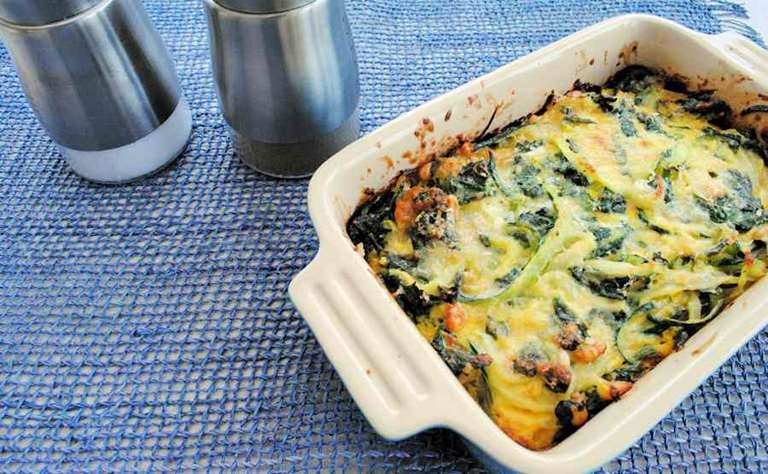
INGREDIENTS
1 large courgette
200g fresh or frozen spinach (thawed)
2 tsp sea salt
2 cloves of garlic, peeled and finely chopped
2 spring onions, chopped
a handful of pine nuts
60ml double cream
1 egg yolk
30g grated hard cheese, Gruyere or Cheddar
20g grated Parmesan
a little olive oil
METHOD
- Wash, top and tail the courgette and cut it into ribbons or noodles on a mandolin or in a spiralizer. Sprinkle with salt, stir it around and place in a colander for at least 10 minutes. After that time rinse it with cold water, squeeze out as much moisture as you can without squashing the courgette, and pat dry with paper towels.
- Rinse the spinach, if using fresh, and wilt it in a microwave or blanch briefly in boiling water. When cool, squeeze out the liquid and chop finely.
- Mix the cream with the egg yolk and add the hard cheese. In a bowl mix the courgette with spinach, pine nuts, garlic and spring onions and most of the Parmesan. Pour over the cream mixture and stir through.
- Preheat the oven to 220C/425F/gas 7.
- Drizzle a little olive oil in the bottom of a tian or gratin dish, transfer the vegetables into it and sprinkle with the remaining Parmesan. Bake for 20 minutes until brown and bubbling. Best serve very warm, instead of piping hot.
From https://www.cuisinefiend.com/242/courgette-and-spinach-tian
Rebecca’s Recipe of the Week: Crushed Carrots
This is a spectacular recipe: the combination of carrots, harissa, and lemony yoghurt is inexplicably delicious. It looks particularly lovely served on a blue plate, and makes an ideal accompaniment to another Ottolenghi showstopper: his warm lentils with tahini.
Crushed Carrots with Harissa and Nuts
Serves 4
Ingredients
1 tablespoon olive oil, plus extra to finish
1 tablespoon butter
1kg carrots, peeled and sliced 2cm chunks
200ml water
grated zest of 1 orange
1 clove garlic, crushed
2 teaspoons harissa paste, or to taste
grated zest of 1 lemon divided into two portions
1 tablespoon lemon juice
150g Greek yogurt
25g shelled unsalted pistachios or cashews, coarsely chopped
Salt and black pepper
Instructions
Place the olive oil and butter in a sauté pan over medium-high heat. Add the carrots and sauté for 6 minutes, stirring often, until they’re soft and take on colour. Add the water, reduce the heat to medium-low, cover the pan, and cook for another 25 minutes, until carrots are completely soft and perhaps a little caramelised, and there is hardly any liquid left.
Transfer the carrots to a food processor, add 3⁄4 teaspoon salt, and blitz to form a coarse paste. Leave to cool, then add orange zest, garlic, harissa, one portion of the lemon zest and the black pepper to taste. Stir to combine.
Mix the yogurt, lemon juice, remaining lemon zest, and 1⁄4 teaspoon salt.
Spread the yogurt mixture on a blue serving platter and spoon the carrots on top. Sprinkle with nuts, drizzle with a little olive oil, and serve.
Recipe adapted from Yotam Ottolenghi, Plenty More (2014).
Rob’s Recipe of the Week: Swedish Summer Sandwich
This week’s recipe is a little niche if you stick to the vegan recipe, especially now that IKEA has closed in Coventry, but it can be adapted with other seafood flavours (the most obvious being actual seafood e.g. prawns). At worst, at least I’m giving you a quick and easy vegan mayo recipe… It’s another that I picked up in Sweden and is an adaptation of the dish “Skagen” which is a sort of seafood toast topper/sandwich filler (£6 for a baguette in the Volvo canteen ouch!). For a while it was my absolute favourite breakfast when combined with cucumber, salad and tomatoes all of which will be abundant in the shares over summer.
Vegan Skagen
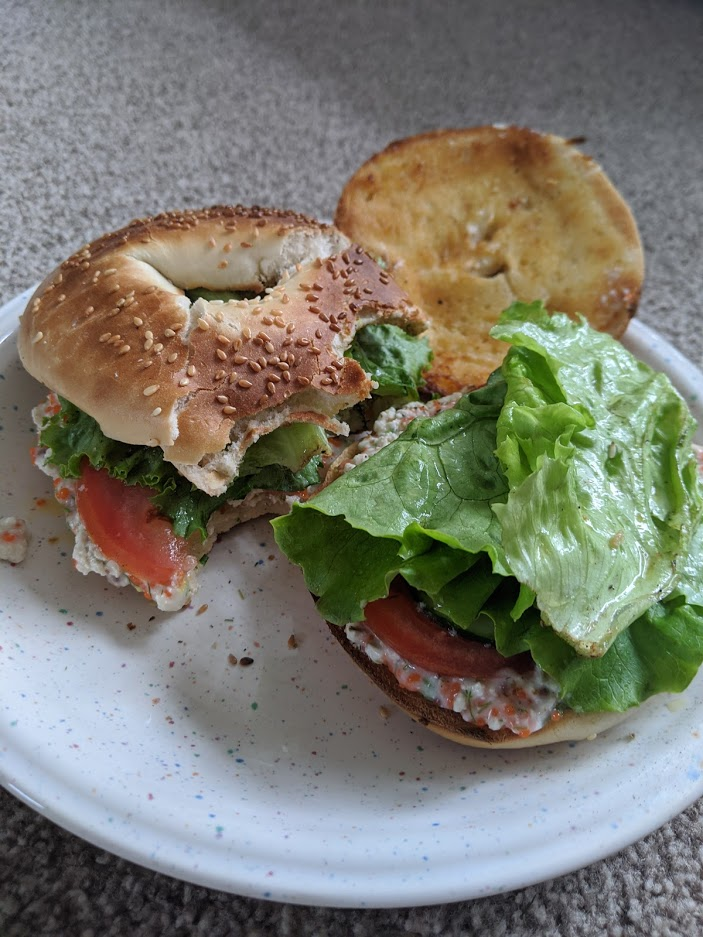
Dry Ingredients:
- 1 jar Seaweed pearls (AKA veggie caviar, available at IKEA)
- Bunch of dill
- 1 pack of tofu, drained and squeezed as much as possible whilst maintaining solid chunks
Mayo:
- 100ml Soya milk (must be soya – I’ve tried with others but they refused to emulsify with the oil)
- 1 tbsn lemon juice
- 1 tsp mustard
- 200 ml oil (preferably rapeseed, other veggie oils work but again can have trouble emulsifying)
To serve:
- Toast
- Lettuce
- Tomato
- Cucumber
- Wedge of lemon (optional)
Method:
For the mayo, combine milk, lemon juice and mustard in a blender (handheld will do) before SLOWLY adding oil as a thin stream whilst blending on a fairly high speed. As you get to the end of the oil the mixture should thicken up to a mayonnaise texture.
Then combine all ingredients in some Tupperware and serve with toast, sliced cucumber/tomato and lettuce. A lemon wedge is a nice addition if you have it.
Rob’s Recipe of the Week: Fancy Mash
Kohlrabi returns to the share this week and whilst I’m not sure mashed potato is really hot-weather suitable, this recipe looked too good to miss. This recipe makes a lot but can be scaled to suit your share size.
Mashed kohlrabi with brown butter
4 servings
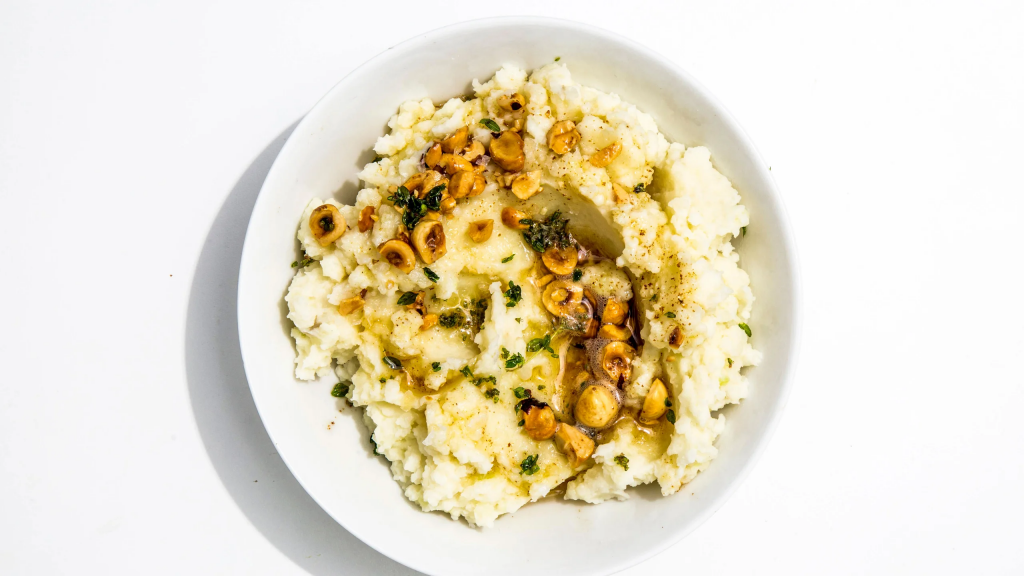
Ingredients
6 tablespoons unsalted butter
⅓ cup blanched hazelnuts
4 thyme sprigs
450g potatoes, peeled, cut into 2cm pieces
salt
900g kohlrabies, peeled, cut into 1cm pieces
⅓ cup double cream
Method
Heat butter in a small saucepan over medium. Cook hazelnuts until butter foams, then browns, about 5 minutes. Add thyme sprigs and cook until crisp, about 30 seconds. Immediately transfer to a bowl; spoon out nuts and coarsely chop.
Meanwhile, boil kohlrabi for 12-14 minutes, adding potatoes to the same pan after a couple of minutes. Whilst you wait, heat cream in a small saucepan over medium until warm.
Drain potatoes/kohlrabi and mash them. Stir in brown butter and warm cream; season with salt. Top mash with hazelnuts and crumble fried thyme over.
Taken from: https://www.bonappetit.com/recipe/mashed-kohlrabi-with-brown-butter
Rebecca’s Recipe of the Week: Why Eat Normal Things When You Can Eat Weird Things?
A while ago I tried a recipe for whole broad beans cooked in a tomato sauce, and it was pretty good. It set me thinking whether you could actually cook the normally-discarded pods (husks?) that are left over when you shell broad beans. It turns out you can. I mentioned this to several friends, who variously told me I’d gone nuts, or that it sounded like the sort of thing people eat in Siberia. What can I say? I thought it was pretty good. We ate this with brown rice and a topping of salted yoghurt, and a shredded carrot salad on the side.
If you would like a normal recipe for broad beans, I strongly recommend this one: spaghetti with broad beans, bread crumbs and marjoram.
Broad Bean Stew
Serves 2
Ingredients
2 tablespoons olive oil
1 large onion, peeled and sliced
Salt and pepper
Leftover husks from about 500g young broad beans (that’s about 300g of broad-bean husks)
Juice of half a lemon
2-3 tablespoons fresh herbs (I used lemon thyme, sage, and dill)
½ cup water
Preparation
Heat the olive oil over low heat and add the sliced onion and a pinch of salt. Cook for 10 minutes, until the onion is soft but not brown.
Meanwhile assess the broad bean husks. You want bright, green, fresh-looking ones. Discard any that look discoloured. Remove any stringy bits along the sides, rather as you’d remove the strings from off the sides of runner beans. Cut the husks into 1-inch pieces.
Add the broad beans to the onions, stir, and cook for a minute.
Add the water, stir, cover, and simmer gently for about 15 minutes, or until the husks are tender. Top up with more water if it seems to be drying out.
Once the husks are tender, add the fresh herbs and lemon juice, and season with freshly-ground black pepper.
If you wish, you can also mix in some cooked broad beans, to make a double-broad-bean stew.
Serve on brown rice with a topping of salted yoghurt mixed with preserved lemon (if you happen to have any to hand).
Rob’s Recipe of the Week: An Unusual Use for Celery
This week I thought I was going to have to go with a Celery soup recipe, but then I came across this gin cocktail which looks worth a try and I guess the celery can still be used as a soup base once it’s served its alcoholic purpose!
Celery tonic

Ingredients:
1 celery stalk, chopped
1 tablespoon sugar
30ml fresh lemon juice
60ml gin
Lemon twist (for serving)
Method:
Muddle celery with sugar and lemon juice in a cocktail shaker, 1 minute. Add gin, fill shaker with ice, and shake until outside of shaker is frosty, about 30 seconds. Strain into a rocks glass filled with ice and garnish with a lemon twist.
Taken from: https://www.bonappetit.com/recipe/celery-tonic
Rebecca’s Recipe of the Week: A Very Elaborate Borscht
In case you have a little time on your hands just now, here is an excellent use of a few hours. The result is the best borscht I, at least, have ever tasted. Alissa Timoshkina, whose recipe this is, notes that if you can make the broth 24 hours in advance, ‘you will be rewarded with an even better tasting soup, but a few hours of resting will also do the trick’.
For the red cabbage sauerkraut, I recommend you get in touch with Canalside member Erica Moody, who makes superb sauerkrauts of all sorts.
Borscht
Serves 4
Ingredients
unrefined sunflower oil, for frying and roasting
1 large onion, finely diced
1 carrot, peeled and grated
6 raw beetroots
2 red peppers
2 tablespoons tomato purée
2 litres cold water
2 bay leaves
1 tablespoon black peppercorns
1 tablespoon coriander seeds
1 tablespoon fennel seeds
4 garlic cloves, peeled
bunch of dill
small bunch of flat leaf parsley
2 garlic cloves, grated
500g red cabbage sauerkraut
2 tablespoons pomegranate molasses
1 red onion
1 tablespoon brown sugar
400g can red kidney beans
2 teaspoons smoked paprika
4 tablespoons soured cream
salt
Preparation
Heat up a tablespoon of sunflower oil in a large pan and fry the onion and carrot for about 8 minutes until golden. Meanwhile, peel and grate 2 of the beetroots and core, deseed and thinly slice 1 red pepper. Add the vegetables to the pan together with the tomato purée and a splash of water. Season with salt to taste and fry for a further 5–8 minutes.
Top with the measured cold water, add the bay leaves along with the peppercorns and all the seeds, whole garlic cloves and half the bunches of dill and parsley. Season with a tablespoon of salt and bring to the boil. Reduce the heat, add the grated garlic and half the sauerkraut with its brine and simmer, covered, over a low heat for 40 minutes–1 hour.
Turn off the heat and let the borscht rest for another hour, while you prepare the rest of the elements.
So far, so good, but here is where the recipe starts to deviate from the norm quite a lot: to prepare the vegetables that will grace the plate and also add extra flavour and texture to the soup, you will need to do a bit of roasting.
Start by preheating the oven to 160°C fan/Gas Mark 4. Peel the remaining 4 beetroots, cut into wedges and dress with oil, salt and the pomegranate molasses. Peel the red onion, cut into wedges and season with salt and the brown sugar to bring out their sweetness and promote caramelization. Place on a roasting tray with the beetroot and roast together for 30 minutes. Drain the kidney beans, then dress them with salt, oil and the smoked paprika. Core and deseed the remaining red pepper, then cut into thin strips and dress with salt and oil. Roast the beans and pepper together, as they will need only 10–15 minutes.
When ready to serve, strain the broth through a sieve or a muslin cloth, discarding the solids. All we need is that rich broth! Reheat again if necessary. Next, create layers of texture and flavour in each bowl by adding a heaped tablespoon of the remaining sauerkraut to each, as well as a handful of roasted beetroot, onion, kidney beans and red pepper. Top each bowl with the hot broth and add a dollop of soured cream and a generous sprinkle of the remaining dill and parsley, chopped. The intensity of the flavours and textures of this dish is beyond words, while the look of the bowl will seduce the eye without a doubt.
Recipe from Alissa Timoshkina, Salt & Time: Recipes from a Russian Kitchen (2019).
Rob’s Recipe of the Week: Potato salad with a new season variation
Potato salad is something that drops off my radar too frequently, but this week we got a large haul of radishes and new potatoes with more expected next week. With that it mind it seems a good idea to make something fresh and easy for lunch in the sun, enjoy!
Potato and radish salad
Serves 4
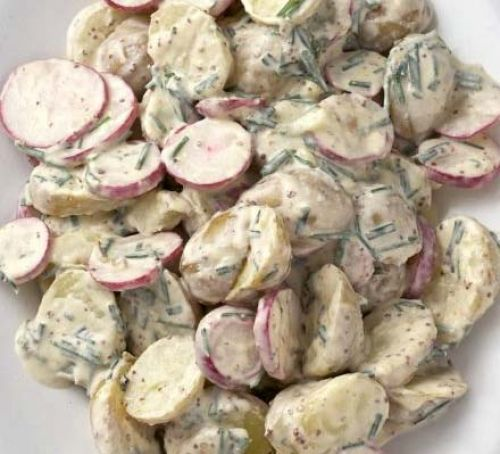
Ingredients
500g new potato, sliced
3 tbsp crème fraîche (I think Oatly and Alpro both do alternatives)
1 tbsp grainy mustard
1 bunch chive, snipped
200g radishes, sliced
Method
Cook the potatoes in a large pan of boiling, salted water for 8-10 mins or until tender. Drain and allow to cool for 10 mins.
Mix the crème fraîche, grainy mustard and chives with some seasoning, then toss through the radishes and potatoes before serving.
Adapted from: https://www.bbcgoodfood.com/recipes/potato-radish-salad